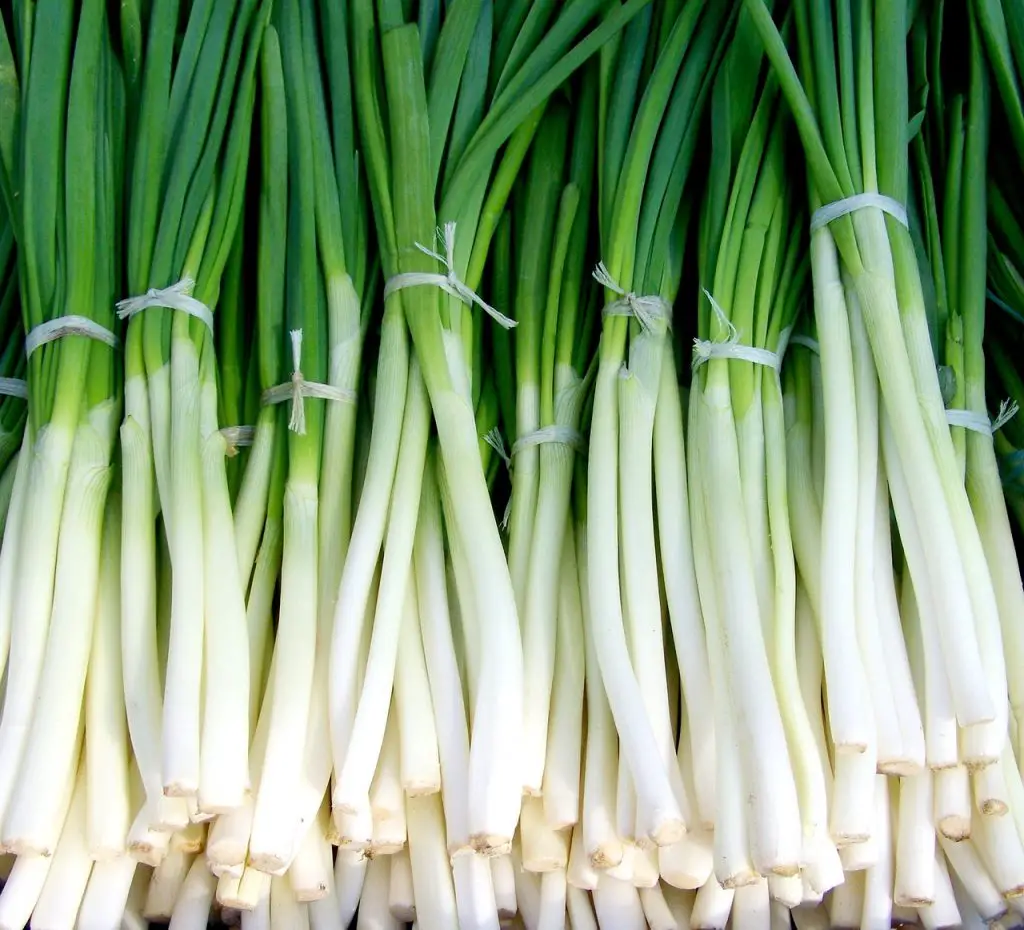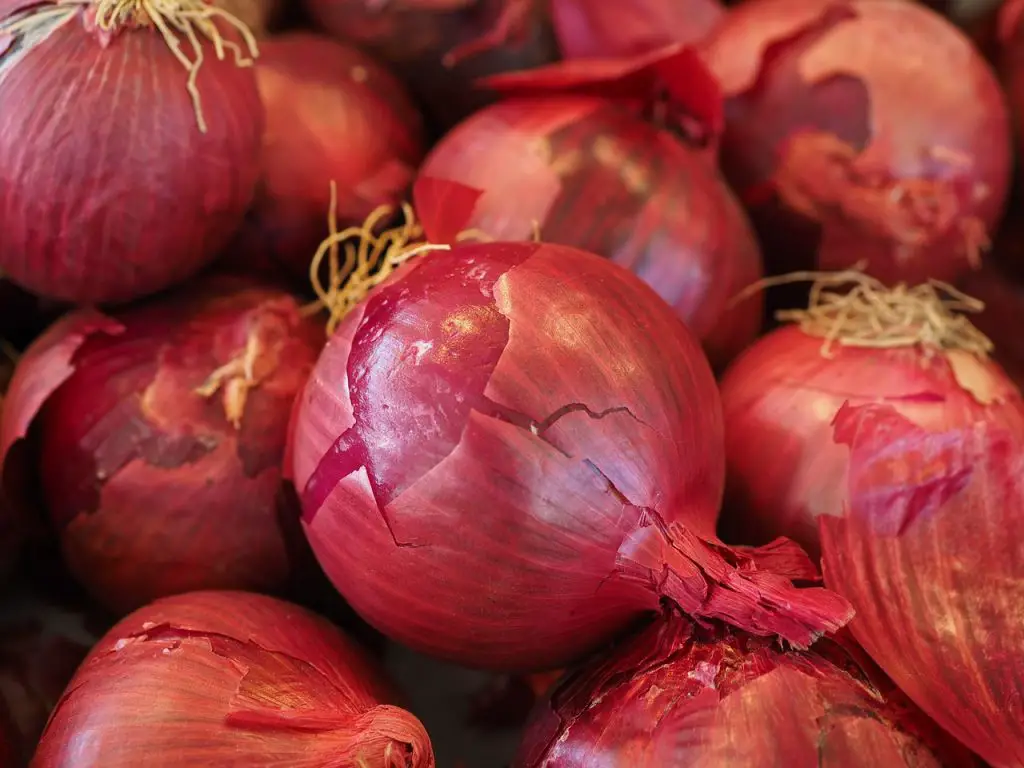Do Onions Grow Underground? Onions are one of the most popular vegetables and are used all over the world in almost every cuisine in some form or another. However, unless you have grown them yourself you may be wondering do they grow above ground or below?
Onion bulbs sit above ground with the base nestled into the soil. The bulb of the onion that we eat is actually not the root of the plant it is what is referred to as a modified stem. The roots of the plant are actually attached to the base of the bulb and are generally relatively short. This section of the plant shrivels up and falls off when the bulb dries out.
The onion bulbs we are presented with in the supermarket are actually dried bulbs where the top growth and the bottom roots of the plant have been removed after shriveling up. Some people may be surprised to learn that the ‘fresh’ onions we purchase from the supermarket are likely to be 6-8 months old.
Are There Different Types Of Onions?
There are a huge variety of onions that are available though only a handful are sold commercially at the major grocery stores. Onions can be divided up into bulbing and non-bulbing varieties.
Non-Bulbing Varieties
The most familiar example of a non-bulbing variety is Spring Onions which are not always green. There are several varieties that are red at the base of the stem and then turn to green higher up the stem.
However, it is worth noting that many of the Spring Onions that are sold in major supermarkets are actually produced using bulbing varieties that are picked when they are young. True non-bulbing varieties are actually called Scallions

Bulbing Varieties
Bulbing varieties of Onions can be classified into three main groups; short, intermediate, and long day Onions. This classification is used by gardeners and refers to the number of daylight hours requires a plant required to form bulbs. All Onion varieties start life out as a thin green shoot. The shoot progress through different sizes from something resembling a chive to then increasing in size to a Spring Onion.
At this point some Onions are picked and sold as Spring Onions, however, when they are left in the ground they will begin to produce bulbs when the day becomes sufficiently long. Where you live in the world will determine what onions can be grown.
The further away you live from the equator the greater choice you will have in terms of the varieties that can be grown. A brief description of the categories of bulb Onions is provided below.
Short Day Onions
Short Day Onions Require Around 10-12 Hours Of Daylight to create a bulb. These varieties can be grown in any region but are the only type that can be grown in regions 35 Degrees Latitude North or South of the equator. The Onions within this group have a sweeter taste due to their higher sugar and water content. The increased water content limits their capacity to be stored making them suitable for immediate use only.
Intermediate Day Onions
These Varieties Require A Day Length Of Around 13 to 14 hours per day, to create a bulb. They are most suited to regions that are between 35 to 45 degrees, from the equator.
Long Day Onions
Long Day refers to Onions that can only be grown at Latitudes of 45 Degrees or more. These varieties require 15 hours or more of daylight, to create a bulb.

How Long Do They Take To Grow?
As mentioned earlier in the article onions can be harvested and eaten at any stage however they will typically take around six to eight months to reach full maturity. It is at this stage that Onions can be properly stored for an extended period of time.
Are Onions Easy To Grow?
Onions are an extremely easy vegetable to grow because they are very cold and drought tolerant. The seeds germinate quickly and can be sowed directly into the ground or started in seed trays. They also have a very wide planting window and seedlings will tolerate being left in trays for an extended period of time.
They are also extremely forgiving with respect to harvesting as they can be harvest pretty much at any stage of their life cycle even after the plant has died back completely. They will even sit out in your garden for an extended period of time provided the weather conditions are not too damp. In damp conditions, the onions will eventually rot.
The onions are also really easy to store for later on in the year, which means anything you grow you will most likely get to eat at some point.
How To Grow Onions?
As mentioned above Onions have a wide planting window as they are hardy frost-tolerant plants that will tolerate temperatures as low as -6°C (20°F). Onions can be grown from either seeds or Onions sets (little bulbs) however, I generally recommend growing them from seeds. To learn more about the advantages and disadvantages click here.
The best time to plant seeds is in late winter to early Spring, however, this is dependent on the particular climate you live in. In locations with milder winter climates, it is possible to plant onion seeds in Autumn however planting the seeds at this stage will only advance your harvest by a matter of weeks rather than months.
Onion seeds can be sown directly into the soil in the garden, however, I recommended that you start Onions in modular trays because it allows greater control over the growing conditions and young seedlings don’t occupy garden space, allowing it to be used for other Winter vegetables.
Multi-Sowing Onions
The most efficient way of planting onions is in a clump rather than individually which many people advise. Sowing in clumps, which is sometimes referred to as multi-sowing, has several advantages.
The first key advantage is that it takes less space in a tray. A modular tray with 30 cells can fit 150 plants. The second key advantage is that the clumps are much faster to transplant and there is less root disturbance.
The third key advantage is that it makes controlling weeds easier as the clumps can be spaced a reasonable distance apart, 10 inches or so, which allows a Dutch Hoe to be used to removed weeds.
However, it is important to note that there are some limitations to the size of the clumps. It is best to aim for 4-5 plants per clump as any more onions than that it a clump will result in small onions. To ensure that you get at 4 plants in a clump it is best to sow 5 to 7 seeds per module as the clumps can be thinned out prior to transplanting them.

Planting Seeds
When planting seeds in a tray it is best to compact the seed raising mix into the cells within the trays as compacting the soil makes handling the clumps of seedlings much easier. The contents of a cell can be taken out as a single plug to minimize root disturbance.
Seeds should be planted at a depth of 0.5 inches (1 cm) and then watered in well. Typically the seeds will take around 6 weeks to reach a decent size however the plants can be left in trays for longer than that if there is no space available in the garden.
Once the seedling clumps are large enough they should be planted 12 inches (30 cm) apart in a sunny location. Ideally, the soil should be rich, moist, and slightly acidic, though Onions are extremely forgiving in this regard.
Once planted Onions require very little maintenance apart from the occasional watering and weeding.
To see the progression of Onions from seeds to harvest I would highly recommend watching the video below from Charles Dowding. He is a well-known market gardener that produces excellent videos that will show the process of onions from start to finish.
Harvesting and Storing Onions
As mentioned earlier in the Onions are a vegetable that can be picked at any stage in its life cycle and eaten, however to maximize the size of onions they need to be allowed to fully mature. Once Onions have reached maturity the tops of the plants turn brown and begin to collapse, at this point, they will not get any larger.
To store Onions the first step is to allow them to dry fully, this will typically take two weeks or so. When the Onions are fully dry the skin will become flaky and the stems will shrivel up completely.
The onions need to be stored in a container that is well ventilated, hessian bags are ideal, however another possible option is to use stackable bread crates as they are wide and flat with plenty of holes in them.
Related Articles
How many varieties of onions are there?
Onion seeds vs Onion Sets – Which is best?
How Many Onions Grow From One Bulb?
Is An Onion A Root Or Stem? What Part Of The Plant Are We Eating?
